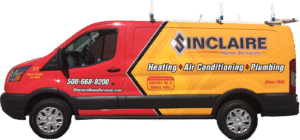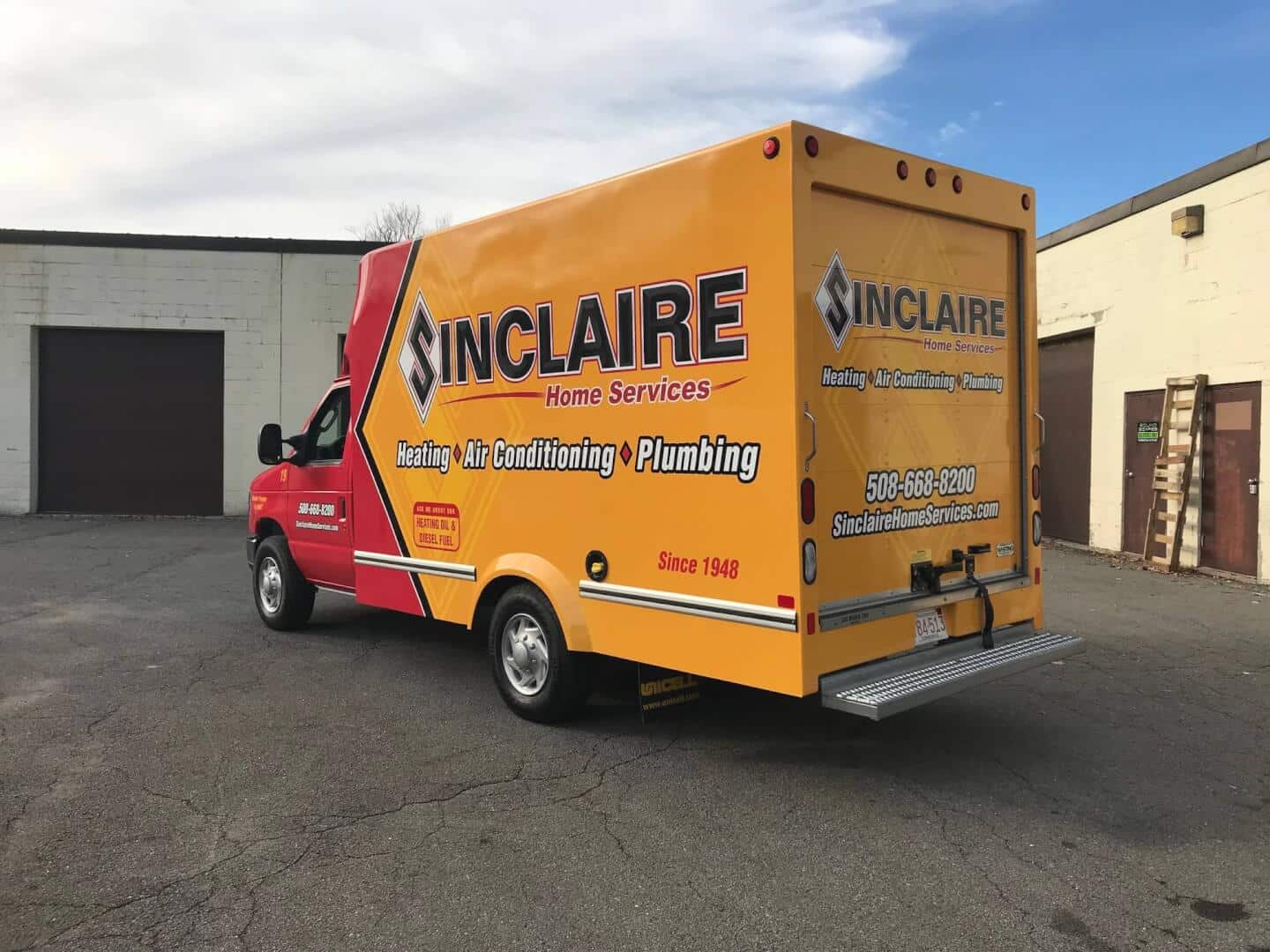Common Problems With Residential Furnaces
BLOG CATEGORIES

140 South St., Walpole, MA 02081
P (508) 668-8200 Toll Free (877) 668-8822
info@sinclaireboston.com
Master Plumber License #9530,
Sheet Metal Master-Unrestricted #5442
Sinclaire Enterprises, Inc.
140 South St., Walpole, MA 02081
P 508.668.8200 Toll Free 877.668.8822 info@sinclaireboston.com
Master Plumber License #9530,
Sheet Metal Master-Unrestricted #5442
need service?
let us contact you
Heating and cooling your home are not possible without your furnace. This article will discuss residential furnaces, their types, common problems with them, and what to do if your furnace exhibits these symptoms. If you’re curious about furnace repair in Milford, this article is for you in particular.

What are Residential Furnaces?
Residential furnaces are self-contained devices used to heat an entire home. Unlike a space heater, they are meant to heat the whole house or apartment, and ducts, registers, and vents help move the heated air to all parts of the home.
The furnace is one of the most critical parts of your heating and cooling system. Setting the thermostat triggers the heater to start pumping out hot air. Following this process, a fan is activated to disperse this heat around your house. Different furnaces have different methods of transferring heat to the surrounding air.
What are the Types of Residential Furnaces?
Natural gas, oil, electric, and propane are the four most common fuel sources for heating appliances. While most furnaces need a heat exchanger or chamber to warm the air around them, electric furnaces expose heated elements to do so. And when the desired temperature is attained, the thermostat turns off the heat.
Furnaces that use natural gas are very cost-effective. Newer gas furnaces may be as efficient as 98%, which significantly improves over the 65% efficiency of previous models. Nearly half of all U.S. households today utilize natural gas for home heating. However, regional variations in use are substantial.
The northeastern United States is the most prevalent region in the country to use oil for heating purposes. While their initial cost is cheaper, they are only 80-90% as efficient as gas furnaces. Furnaces that use natural gas might be up to 25% more expensive than their alternatives.
Aside from being the most affordable option, electric furnaces also have the advantages of being the simplest to set up and lasting up to ten years longer than their gas and oil counterparts. However, you’ll have to factor in the difference between how much electricity costs and how much gas costs each month.
Production of oil and natural gas results in the byproduct of propane. Around 10 percent of American homes utilize it because it is convenient to store in tanks. This is a fantastic alternative if gasoline and oil are too costly or scarce where you live.
No matter what kind of furnace you have, furnace repair in Milton is available to you from Sinclaire Home Services.
What are Common Problems with Residential Furnaces?
While different types of furnaces may have specific issues to their types, some problems pop up for all furnaces after many faithful years of keeping your home warm and cozy. Keep reading for the most common problems that might require furnace repair in Milford.
The Thermostat is not Working
A lack of heat from a furnace is usually a reason for concern, but there may be other, less serious explanations. If your thermostat has a fan setting, it might explain why your furnace is moving air but not heating anything. The furnace’s fan setting circulates air but does not heat it. Therefore, it is just helpful for ventilation.
The thermostat not being on, not being set to “heat,” or having an insufficient temperature setting are all potential causes of a lack of heat from your furnace. First things first, if your furnace isn’t working right: check the thermostat to make sure it’s adjusted correctly.
Solution: After ruling out the thermostat, the pilot light should be checked. In such a scenario, having a professional look at the furnace and diagnosing whether you require furnace repair in Milford is your best bet.
The Furnace is not Producing any Heat or not Producing Enough Heat
The air filter in your furnace keeps contaminants like dust and lint from being distributed throughout your house through the ventilation system. If you have pets or a big family, you should change the filter every month and at least once per winter. The filter might get blocked if it is not changed often enough. Due to the accumulation of dust and debris, the airflow from the furnace is restricted, giving a false impression that the device is not generating any heat. Changing the filter might solve the problem.
A lack of a flame to ignite the fuel and heat the air is another possible cause of a non-working furnace. The furnace’s pilot light ignites the fuel within the device. The pilot light’s flame may eventually go out on older versions since it burns constantly. Electronic ignition is often found in newer furnaces and lights the pilot when the furnace is turned on. Problems with the ignition may prevent the flame from igniting, rendering the furnace ineffective in producing heat.
Solution: If replacing your air filter and troubleshooting the pilot light doesn’t resolve your problem, contact a professional to determine whether you need furnace repair in Milton.
The Furnace is not Turning on Automatically
When the thermostat tells the furnace to turn on, it should do so and begin producing heat if everything is operating as it should. However, if it hasn’t been coming on and things are starting to get cold in the house, there may be a problem. The issue might be easily remedied or indicate a more serious problem with the heating system.
If you switch off the circuit breaker for your furnace, the furnace won’t work. Check the breaker box and try the “furnace” switch if the machinery is not functioning. That may be the only thing you need to do to restart the process.
Your thermostat is another potential problem if your heating system won’t switch on. Your furnace won’t turn on until it reaches the temperature set on the thermostat, which may take some time if the setting you’ve set it at is too low. The heating system will not activate if the thermostat is set to “cool” or “off.” Examine the thermostat and make any necessary adjustments to see if you can get your heating system to turn on.
Solution: If troubleshooting rules out the circuit breaker and the thermostat, contact your HVAC professional to see if you need furnace repair in Milton.
The Furnace Stopped Working Altogether
A new cycle for your heater began when it abruptly turned off before the room reached the desired temperature. A furnace can cease operating for various reasons, including tripping the circuit breaker, a problem with the pilot light or ignition, a restriction in the airflow, or activating a safety switch.
Solution: If your furnace has turned off and you have no idea why you should have a professional look at it and decide whether you require furnace repair in Milford.
The Furnace Makes a Lot of Noise
When running, most furnaces have an audible background hum. A “whooshing” sound is typical when air moves through your ducts, and you may hear clicks when the thermostat senses a specific temperature and sends a signal to the furnace. Some heaters have louder blowers than others.
However, certain sounds indicate that your system has a problem and that the machinery needs to be checked, fixed, or even replaced. For example, if your furnace is creating a banging or rattling sound, it may be a warning that something has become loose and needs to be tightened or corrected. Because of residual fuel in the combustion chamber, your furnace may create a loud rumbling noise after the system has been turned off.
Solution: In either scenario, the furnace should be turned off, and a professional should be called in to handle the situation.
The Furnace is Leaking Water
Condensation leaks are a common problem for certain furnaces, leading to a puddle near the appliance’s base. A cool exhaust function is often included in high-efficiency furnaces with 90% or above AFUE ratings. PVC, rather than metal, is typically used in the exhaust pipes of modern, energy-efficient furnaces. The water condensed from the cooling combustion fuel is sent to a drain through condensation pipes. Water might collect at the base of the furnace if the condensation line gets blocked or springs a leak.
Solution: If that occurs, having a professional diagnose whether you need furnace repair in Milford is the best action to take.
Conclusion
While there are several common residential furnace problems with easy solutions, if you find you are continuing to have issues after troubleshooting, you should contact a nearby furnace repair business as soon as possible. Sinclaire Home Services proudly serves residential customers in the Milton and Milford areas. Contact us today to have an HVAC professional help you solve your residential furnace problems.
OUR SERVICE AREAS
- Ashland, Ma
- Attleboro, Ma
- Bellingham, Ma
- BLACKSTONE, MA
- BRIDGEWATER, MA
- Canton, Ma
- Dedham, Ma
- Dover, Ma
- EAST BRIDGEWATER, MA
- Easton, Ma
- Foxborough, Ma
- Framingham, Ma
- Franklin, Ma
- Holliston, Ma
- HOPEDALE, MA
- Hopkinton, Ma
- Mansfield, Ma
- Medfield, Ma
- Medway, Ma
- MENDON, MA
- MILFORD, MA
- MILLIS, MA
- MILLVILLE, MA
- MILTON, MA
- NATICK, MA
- NEEDHAM, MA
- NEWTON, MA
- NORFOLK, MA
- NORTH ATTLEBORO, MA
- NORTON, MA
- NORWOOD, MA
- PLAINVILLE, MA
- RANDOLPH, MA
- SHARON, MA
- SHERBORN, MA
- STOUGHTON, MA
- SUDBURY, MA
- TAUNTON, MA
- WALPOLE, MA
- WAYLAND, MA
- WELLESLEY, MA
- WEST BRIDGEWATER, MA
- WEST ROXBURY, MA
- WESTON, MA
- WESTWOOD, MA
- WRENTHAM, MA
AFFILIATIONS





